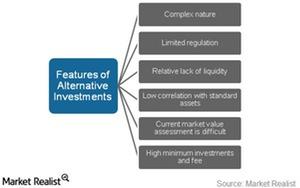What are alternative investments?
Alternative investments seek to provide a hedge against various market risks by following hedge fund-like strategies.
Dec. 12 2014, Published 2:14 a.m. ET

Hedge funds: to hedge against risk
Hedge funds generally provide 4%–6% return over risk-free. When risk-free is at zero, as it has been in the US since the financial crisis, hedge funds typically provide around 4%–6% return. This may not seem as exciting to investors.
However, when the risk-free interest rate rises, bond prices go down. This is where hedge funds become the perfect alternative to fixed income funds.
Recently, asset managers including Ameriprise Financial Inc. (AMP) have been diversifying beyond traditional stocks and bonds. The company’s Columbia Management announced an agreement in November 2014 to join with Blackstone Group LP (BX) to increase retail investors’ access to hedge fund strategies.
What are alternative investments?
An alternative investment is an investment in asset classes other than stocks, bonds, and cash. Alternative investments seek to provide a hedge against various market risks by following hedge fund-like strategies. Alternative investments include hedge funds, managed futures, real estate, commodities, and derivatives contracts, among others. They are mostly held by institutional investors or accredited, high-net-worth individuals. Alternative investments are sometimes used as a tool to reduce overall investment risk through diversification.
IndexIQ’s IQ Hedge Multi-Strategy Tracker ETF (QAI) is the most popular ETF in the alternatives category. The fund’s top five holdings include the Vanguard Total Bond Market ETF (BND), the Vanguard Short-Term Bond ETF (BSV), the PowerShares Senior Loan ETF (BKLN), the iShares Russell 2000 Growth ETF (IWO), and the iShares 1-3 Year Treasury Bond ETF (SHY).
Liquid alternative investments, or liquid alts, are another popular variant of alternative investments.
